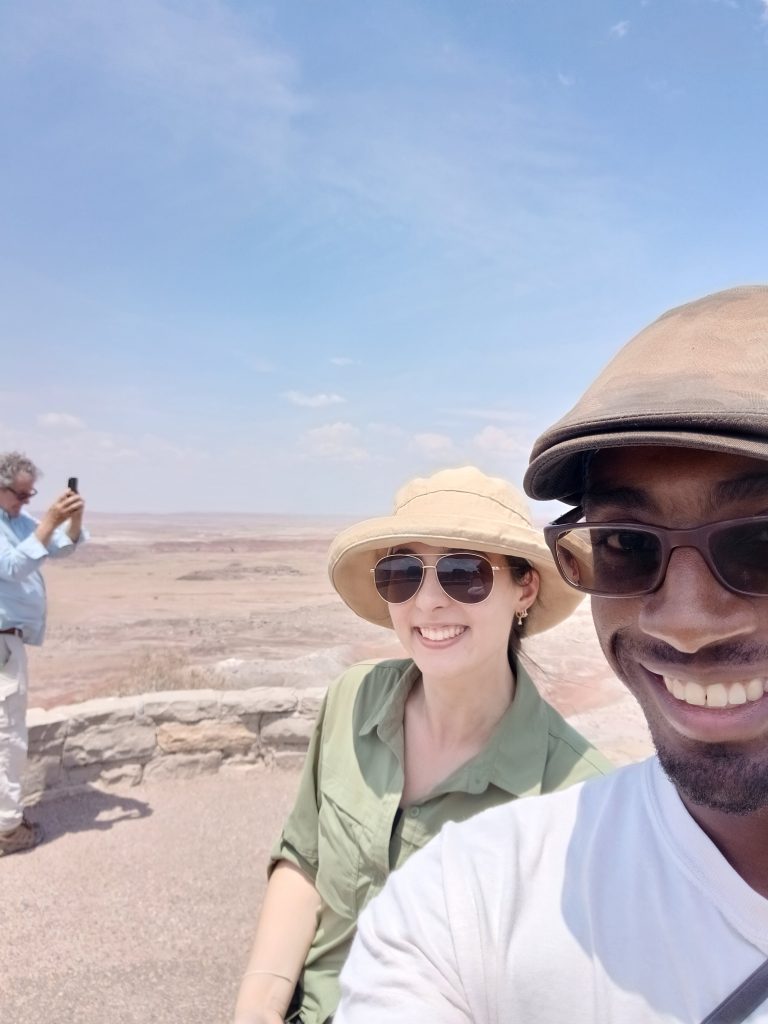With an average high of 108 degrees Fahrenheit, July is historically the warmest month of the year in Chinle, Ariz. It’s also a red-hot season for fossil hunting thanks to Jonathan Weinbaum, associate professor of biology, who includes Southern undergraduate and graduate students on his paleontological research team in Arizona during academic breaks.
It’s one of countless examples of Southern’s commitment to research and experiential learning — one formally recognized this year when the university became Connecticut’s first and only Carnegie-designated Research 2 (R2) university. (Yale and UConn are the state’s sole R1-designated universities based on research expenditures and the number of students granted doctorates.)
Southern’s new R2 designation places it in the sweet spot: small class sizes, close faculty-student collaboration, and research opportunities for both undergraduate and graduate students.
Last summer, Southern graduate students Adé Ben-Salahuddin, ’25, and Danielle Hill, ’23, joined Weinbaum’s field expedition to the Chinle Formation in Arizona, a fossil-rich site dating back to the Late Triassic Period more than 200 million years ago. The results were by all accounts spectacular. “The most challenging part was finding too many fossils. . . . So many fossils, so little time,” says Ben-Salahuddin of the bountiful discoveries and intricate excavation work required.

Weinbaum and colleagues have been excavating this quarry for about 10 years. The region’s unique geology reveals an ancient landscape that shifted from a wet, rainforest-type environment at the bottom to a full-blown desert at the very top.
While the researchers occasionally find dinosaur fossils, most of the discoveries have been early relatives of crocodiles. These relatives and ancestors were very different animals than what we know today and were endothermic or warm-blooded. “Truth is always stranger than fiction,” says Weinbaum.
Learning in the field
It was the second trip to the region for Ben-Salahuddin, whose interest in paleontology began in childhood through nature-focused books and endless nights of Animal Planet and Discovery Channel programs. Walking with Dinosaurs and When Dinosaurs Roamed America were favorites. He initially attended Yale University, where he worked as a curatorial assistant with the vertebrate paleontology collections at the Peabody Museum. In 2022, he volunteered as a researcher with the Audubon Society’s Seabird Institute in Maine.


Ben-Salahuddin now is a researcher in Weinbaum’s laboratory; his trips to the Southwest to work with the professor were “the first and so far only field paleontology experiences I’ve done,” he says.
“This experience, which started in my undergraduate years at SCSU, has given me a good taste of the range of things a paleontologist does in addition to finding and studying fossils — from collection management to fossil preparation and public outreach,” says Ben-Salahuddin, noting he has worked in each of these areas in the last year. All have confirmed his desire to pursue a career in paleontological research at the master’s level and beyond.
For Hill, who grew up in an environment where evolution was a taboo subject, the fieldwork was equally transformative. She transferred from community college to Southern, where she expected to become a biology teacher.
“I never could have imagined working in paleontology let alone having the opportunity to participate in fieldwork,” she says. Her Bio 460 — Paleontology course taught by Weinbaum changed everything, “solidifying in my mind that I wanted to pursue paleontological research,” she says. Hill switched majors, earned a bachelor’s degree in biology, and enrolled in the master’s program in biology.
The field expedition to the Chinle Formation was her first. It’s also a full-circle moment. She works in Weinbaum’s laboratory, where she is studying the collection of phytosaur material to uncover clues about the diversity within “our particular slice of Chinle Formation.”


“Arizona in July is a beast, especially for us New Englanders,” says Hill. “But when you unearth bones that haven’t seen that same sun in 213 million years, the discomfort goes away. The feeling of ‘I can do this’ coupled with nerdy-fossil-joy is so entirely rewarding.”
The trip also included collaboration with colleagues from the Texas Tech Museum and visits to iconic landmarks including the Petrified Forest, Meteor Crater, and the Grand Canyon.
And the learning continues. Both students presented posters at Southern’s Research and Creative Conference based, in part, on the area’s discoveries; the university offers the conferences at both the undergraduate and graduate levels.)
Weinbaum, who has led excavations at the quarry for more than a decade, says the experience is transformative — not only for the students but for him as an educator. “It is so important to give students opportunities they wouldn’t ordinarily have. It is life-changing,” he says of Southern’s commitment to research and hands-on learning. “I think that sentiment is shared by many of the faculty at Southern.”

![IMG_5807[66] A group self with an expanse of brown ground and sky in the background.](https://news.southernct.edu/wp-content/uploads/2025/09/IMG_580766-696x522.jpg)
